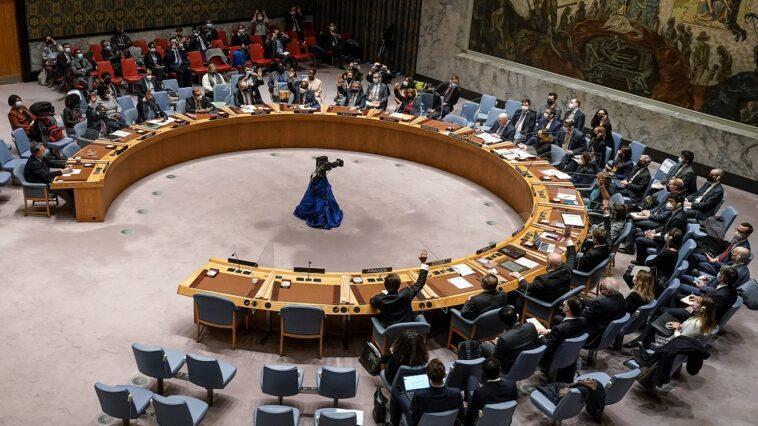Moscow has threatened this Thursday to deploy nuclear weapons together with the Nordic countries if Finland and Sweden join NATO, as they have hinted in recent days. “There will be nothing more to talk about any non-nuclear status of the Baltic [Sea] region, the balance will have to be restored,” said the vice president of the Russian Security Council and former president Dmitry Medvedev. However, the countries of the region warn that the zone is not demilitarized and Russia already has nuclear weapons in the enclave of Kaliningrad. “The international community is aware of it,” Lithuanian Defense Minister Arvidas Anusauskas responded.
In addition to threatening to send nuclear weapons, Medvedev has also advanced that this accession would mean that Russia would deploy more troops in the area. “If Sweden and Finland join NATO, the land border will double and naturally will have to be reinforced. It will be necessary to drastically increase land and air defenses, and deploy significant naval forces in the Gulf of Finland”, said the former Russian president and former prime minister.
Despite the fact that Sweden and Finland are not members of NATO, or are not yet, their representatives frequently attend the meetings held by the members of the transatlantic organization. The collaboration between the two Nordic countries and the Alliance has increased in recent years; Finnish and Swedish soldiers have taken part in military exercises organized by NATO – like the ones last March in northern Norway – and since the bombs started falling in Ukraine, the ministers (Foreign and Defense) have taken part in all the transatlantic group dating This has led Alliance Secretary-General Jens Stoltenberg to say that the 30 NATO members would welcome the two Nordic countries with open arms if they decide to take the plunge.
“It is a decision that they must make from their autonomy and sovereignty,” Stoltenberg said last week, before the last meeting of the foreign ministers. Although he also stressed that “they could easily integrate into the organization if they decide to take the step”, a phrase, the latter, sounded almost like a formal invitation to join. “I am sure that we will find a way to resolve the concerns that they may have about the period between the possible request and the final ratification”, the Norwegian stressed, before a scenario in which Russian threats resonate and the fact that the umbrella of collective security, which ensures that in the face of aggression against a member of the Alliance, everyone reacts in its defense, would not yet be in force.
The latter suggests that for Sweden and Finland there may be a fast track to entry. Given this, NATO remembers that the Alliance has a series of shared values, such as democracy, which in the case of the two Nordic countries are accredited. This starting point would give them an advantage over others waiting to join, such as Georgia, which also has two conflict zones in its territory—. “There are no countries closer to the coalition,” Stoltenberg went on to say, referring to the years of collaboration between the two northern European neighbors and NATO, which became closer especially after the Russian annexation of the Ukrainian peninsula of Crimea, in 2014. “That is why I believe that the accession process of these countries can be quite fluid because we know that they are already very close to NATO”, added the secretary-general.
Nuclear weapons in Kaliningrad
The Lithuanian Defense Minister responded this Thursday to Medvedev’s statements about the deployment of nuclear weapons in the Baltic region: “Russian threats are a bit strange when we know that, even without the current situation, [Moscow] has weapons 100 kilometers from our border.” “They have always stored nuclear weapons in Kaliningrad (a Russian enclave bordering Poland and Lithuania). The international community, the countries of the region, are perfectly aware of this. They use it as a threat”, Anusauskas added to the BNS channel.
In addition, the nuclear balance in the region could also be altered by the actions of the Kremlin’s most faithful ally, the regime of Aleksandr Lukashenko. At the end of February, three days after the start of the war in Ukraine, the Belarusian government promoted a constitutional reform that contemplates the deployment of Russian weapons of mass destruction in its territory, which borders three NATO members: Poland, Lithuania, and Latvia. . Days before the invasion of Ukraine began, Lukashenko and Putin together witnessed an exhibition of the wide range of missiles capable of carrying nuclear warheads that Moscow has.
Change in the geopolitical chessboard
The Kremlin’s threats to Sweden and Finland have been constant since the end of 2021. On December 24, the spokeswoman for the Russian Foreign Ministry, Maria Zajárova, warned Stockholm and Helsinki that there would be “serious political and military consequences” if they decided to enter. in the military bloc. Since then, the Kremlin’s intimidating statements have been repeated almost weekly. However, the chances of Sweden and Finland joining the Alliance are now greater than ever. Support for integration has spread among a large part of the parliamentary arc of both countries, while various surveys show a radical change in public opinion: for the first time, a majority of the population of both countries is in favor of joining NATO. In the Finnish case,
The Prime Minister of Finland, Sanna Marin, declared this Wednesday after meeting in Stockholm with her Swedish counterpart, Magdalena Andersson, that Helsinki will decide “in the coming weeks” whether or not to request its entry into NATO. The Scandinavian president was more cautious, although she did not deny the possibility that Sweden would formalize its request for accession next summer, during the Alliance summit to be held at the end of June in Madrid.
If Sweden and Finland finally join the military organization, the number of allied countries would reach 32. And the border between the Alliance and Russia would be slightly more than twice as long as it is today. The governments of Andersson and Marin have announced in recent weeks that they will increase military spending in the coming years by more than 2% – the figure agreed by the NATO allies at the 2014 Wales summit.




GIPHY App Key not set. Please check settings